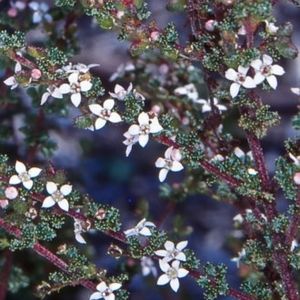Araluen Zieria facts for kids
Quick facts for kids Araluen zieria |
|
|---|---|
 |
|
| Zieria adenophora in the ANBG | |
| Conservation status | |
| Scientific classification | |
| Genus: |
Zieria
|
| Species: |
adenophora
|
The Zieria adenophora, often called the Araluen Zieria, is a unique plant. It belongs to the plant family called Rutaceae, which is the same family as citrus fruits like oranges! This special shrub is only found in a small area near Araluen in New South Wales, Australia.
The Araluen Zieria is a spreading shrub. It has small, glossy (shiny) leaves that feel a bit bumpy. In spring, it grows beautiful white or pale pink flowers with four petals. This plant is very rare, with fewer than one hundred plants known to exist in just one location.
Contents
What Does It Look Like?
The Araluen Zieria is an openly branched shrub. It usually grows to be about 0.5 to 1 meter (about 1.5 to 3 feet) tall. Its branches are covered with many small, wart-like bumps called tubercles.
Leaves and Scent
The leaves of this plant have a strong, pleasant smell. Each leaf is made up of three smaller parts called leaflets. These leaflets are shaped like a wedge or an egg. They are about 2.5 to 4 millimeters (about 0.1 to 0.16 inches) long and 2 to 3 millimeters (about 0.08 to 0.12 inches) wide. The stalk that holds the leaflets is about 2 millimeters (about 0.08 inches) long. Both sides of the leaves are bumpy and mostly smooth, meaning they don't have many hairs.

Flowers and Fruit
The flowers of the Araluen Zieria are white or a very light pink. They grow in groups of one to three where the leaves meet the stem (this spot is called a leaf axil). Each flower is about 5 millimeters (about 0.2 inches) across. They have small, triangular parts at the base called sepals.
The flowers also have four petals that are shaped like a spearhead. These petals are about 2 to 3 millimeters (about 0.08 to 0.12 inches) long. The plant flowers in spring. After the flowers, it produces bumpy fruits called capsules. These capsules are about 5 millimeters (about 0.2 inches) wide and are divided into four sections. Each section usually holds one or two seeds.
How It Got Its Name
Naming the Araluen Zieria
The Araluen Zieria, or Zieria adenophora, was officially described in 1941. A scientist named William Blakely first studied a plant sample found near Bells Creek Falls in Araluen. He published his description in a scientific paper called Contributions from the New South Wales National Herbarium.
Meaning of adenophora
The second part of its scientific name, adenophora, comes from two old Ancient Greek words. The word aden means "gland," and the part -phor means "to bear," "to carry," or "to have." This name likely refers to the plant's bumpy, gland-like features on its leaves and branches.
Where It Lives
The Araluen Zieria grows on rocky hillsides. It likes to be near large granite boulders in areas with many shrubs. As mentioned, this plant is only found in the Araluen district of New South Wales. It's a very specific place where it thrives!
Protecting This Plant
The Araluen Zieria is a very rare plant. It is listed as "Endangered" under important laws in Australia. These laws include the New South Wales Threatened Species Conservation Act and the Australian Government's Environment Protection and Biodiversity Conservation Act 1999 (EPBC) Act. This means it's at high risk of disappearing forever if we don't protect it.
In 2001, scientists knew of only 56 adult Araluen Zieria plants left. One big problem for these plants was being trampled by feral goats. These goats would walk all over the plants and eat them. To help protect the plants, a fence has been built around their habitat. This fence helps keep grazing animals away and gives the Araluen Zieria a better chance to survive and grow.
See also
 In Spanish: Zieria adenophora para niños
In Spanish: Zieria adenophora para niños


